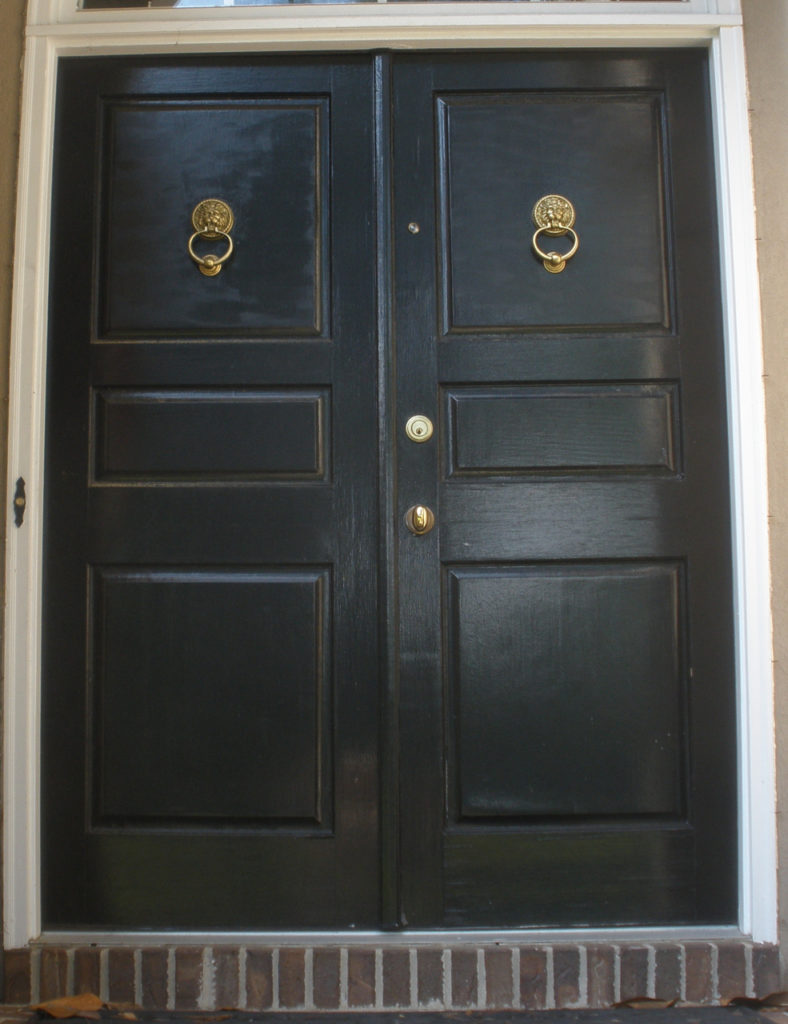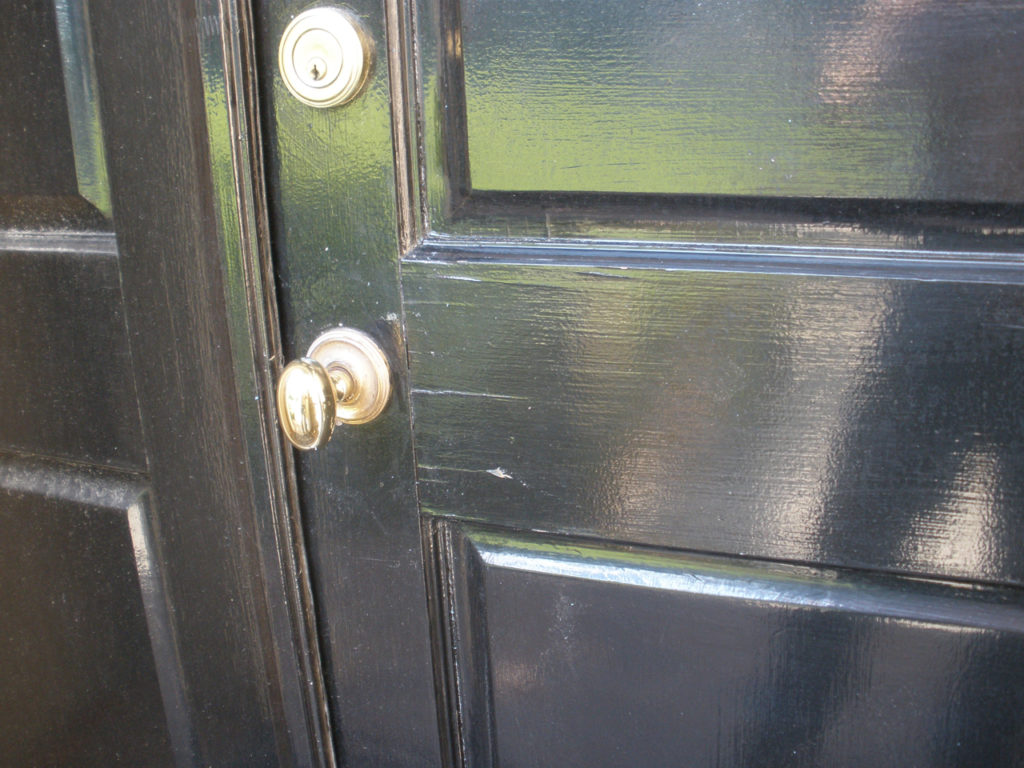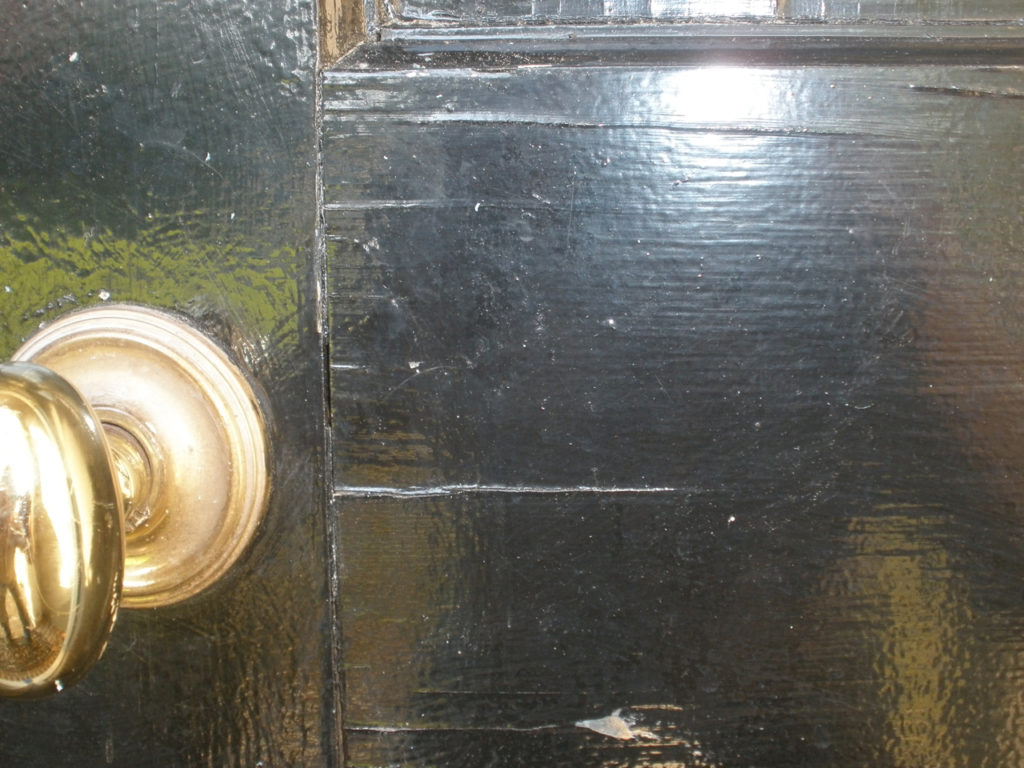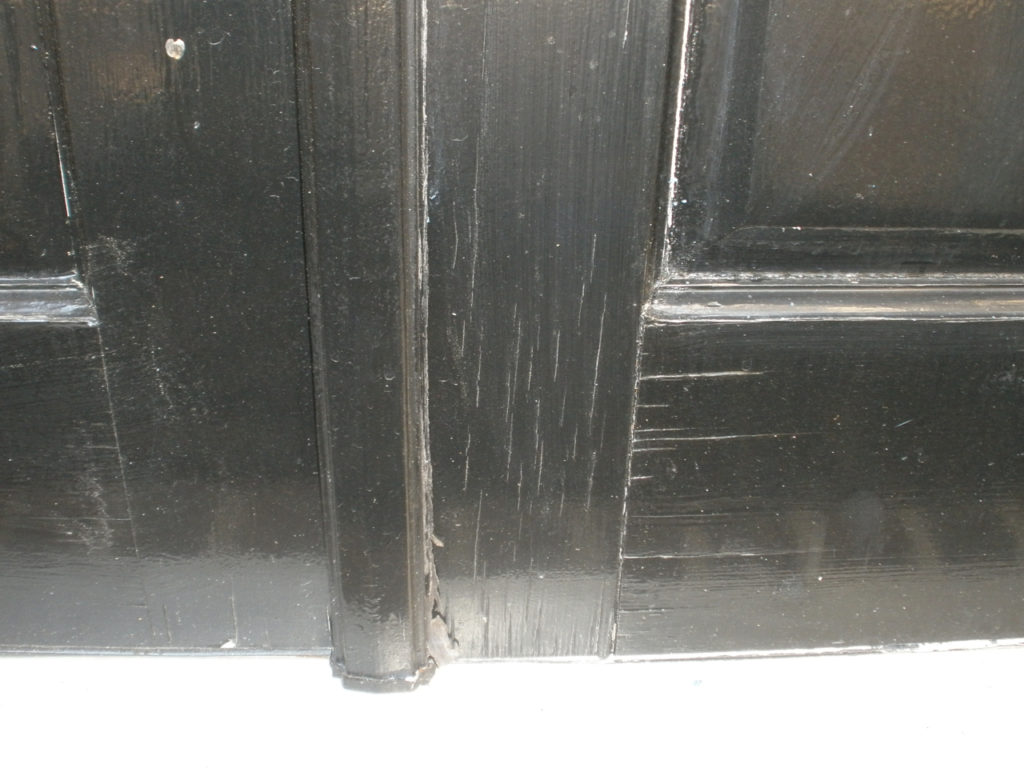We may receive a commission when you use our affiliate links. However, this does not impact our recommendations.

Here are the front doors the reader asked about.
A reader had a problem with the paint on his front doors, which he thought might be caused by exposure to strong sunlight for many hours each day. Fortunately, he sent pictures, which told me a different story. From the pictures, it seemed more likely that the damage was caused by moisture.
UV sunlight causes painted surfaces to fade, dull and eventually chalk. The paint on these doors appears to be in quite good shape (though maybe a little thick).
What appears to have happened is one of the most common exterior paint problems. Moisture finds gaps where it can get into the wood underneath the paint, and in end-grain situations works its way down the wood and causes the paint to separate.
This problem is very common in cross-grain situations where wood siding butts up against window or doorframes. It also occurs in situations like this one where rails butt up against stiles (vertical boards).

Here’s a view of the problem on the middle rail.

Here’s a close-up view.
With these doors, water has also entered the stiles from the bottom and caused some separation.

This picture shows the peeling caused by water entering the stiles from the bottom, and also some peeling in the bottom rail.
In the case of siding butting against frames, you can keep the moisture out by applying caulk to the joints, and this is commonly done. But in the case of these doors, there’s almost nothing you can do to prevent the problem from occurring except constant maintenance or build an overhang to keep rain from wetting the doors.
The problem is that the boards will shrink and expand across the grain but not along the grain with humidity changes. Here, the sun exposure could have some impact by drying out the wood so it shrinks a little more, but the sun is by far the minor factor. It’s humidity changes from winter to spring and summer and back that has the most impact.
What to do now with these doors? Here’s what I suggested.
Sand or scrape level the raised areas of paint and any parts of the moldings where the paint is peeling, dig the paint and crud out of the gaps in the cross-grain joints, fill them with wood putty, sand the putty level, put a coat of primer over all the areas where you have removed paint, then repaint the entire doors.
For the bottom of the styles, to avoid removing the heavy doors, work some sandpaper underneath and sand lightly just to clean the surfaces. Then soak a cloth or paper towel with a thin finish such as wiping varnish (varnish or polyurethane thinned about half with mineral spirits) and slide it underneath, protecting the floor with plastic or a very thin sheet of metal. Let the thinned varnish wick up into the end grain, sealing it from moisture penetration.
As for the type of paint to use, oil-base or water-based, it’s best to stick with the same type that is now on the doors. To test the paint, dab on a little acetone, lacquer thinner, xylene or toluene. Each of these solvents will cause water-based paint to smudge and get sticky pretty quickly, within seconds. They won’t cause this on oil-based paint, but they could cause the paint to blister if you leave the solvent in contact for a long time.
Sanding, scraping, filling and repainting aren’t going to solve the problem permanently, because the wood still shrinks and expands. So gaps where moisture can penetrate will still open up and have to be kept filled. The alternative of stripping and repainting isn’t going to solve the problem either because new paint won’t stop the gaps from opening up.
Here are some supplies and tools we find essential in our everyday work around the shop. We may receive a commission from sales referred by our links; however, we have carefully selected these products for their usefulness and quality.










Another noteworthy point is to make sure you use wood paint, not metal paint.
My garage has metal passage doors and wood overhead doors. I used metal paint on all doors and the wood doors looked like the above pictures in two years. I scraped off all loose paint and repainted the wood door with wood paint from the same manufacturer and it looks as good 3 years later.
I made a point of of the metal paint failure on the wood door to my local retailer who had told me initially to go ahead and use the metal paint on all doors because, “everyone” knows metal paint is better. Would also save purchasing two cans of paint.
I installed douglas fir stair treads with a bullnose profile on the north side of my house cut to length out of long (12′ ?) pieces and finished with CPES, a penetrating epoxy often used in marine applications, and a two part polyester paint; both from http://www.rotdoctor.com. as I remember I used two coats of the epoxy and perhaps an additional coat on the end grain with two coats of the polyester paint overall. this combination has survived 11 upstate NY winters without noticeable damage to the finish or to the wood, i.e. no cracking, peeling, checks, warping, cupping etc, and note this particular stair enjoys freeze/thaw from a gutter above when conditions are suitable for ice dams and regularly gets direct snow. the only damage is to the non-slip stick-on patches I applied later after I found out how slick the polyester is with a light coat of snow. had I known to add a little sand to the paint when I mixed it rather than the stick-on patches I expect there would be no damage at all (mind you the stick-ons were nearly intact for about 9 winters before starting to come apart which I assume is because the patch adhesive was very compatible with the paint; also I cleaned the surface with xylol before applying them). one other thing, as this stair is on the north side it only gets direct sun for part of the year.
CPES is a 50:50 two part epoxy that has mixed viscosity about the same as water or perhaps less, i.e. the end grain can suck up a lot of it, but because the pot life is fairly long you can just keep painting it on until it stops taking it up. two coats of it provides slight build, but it is nothing like the thick stuff you see on bar top finishes. if you google for it you can find a lot of discussion on marine forums. note epoxy by itself will not stand up to UV, so it must have a topcoat.
the rot doctor doesn’t sell that particular paint now, probably due to concerns about toxicity, but they sell other high durability paints. they are quite expensive, but after 11 years I don’t recall the pain at all. by contrast my front steps were finished by a contractor at about the same time and whatever he used is essentially all gone; further the front steps get almost zero use because all the house traffic goes in via the north steps so the damage is essentially all from weather and none from foot traffic.
obviously paint isn’t appropriate everywhere, but where it is acceptable it is possible to put on a finish that will last many years with zero maintenance. I doubt any kind of clear finish, e.g. marine spar varnish, would last as well without maintenance. of course YMMV.
In the marine trades, it is pretty commonly known that wood can be prevented from changing moisture content and from changing dimensions with changes of moisture content by encapsulating the wood in a waterproof coating. In such cases, epoxy resins are typically called into action. Joints are adhered with epoxy adhesive formulations, exposed surfaces are coated with epoxy resin and (since epoxies are fairly quickly degraded by UV light) the cured resin is painted or varnished (with UV blockers in the varnish).
With no more than normal maintenance of the top coat, even horizontal structures on deck in full exposure to sun an rain can perform admirably or, as is said by old-timers, “ship-shape and Bristol fashion.” Of course normal maintenance of even the very best varnish takes at least yearly light sanding and a light coat or two of new varnish, Paint, on the other hand, can go for years with very little attention.